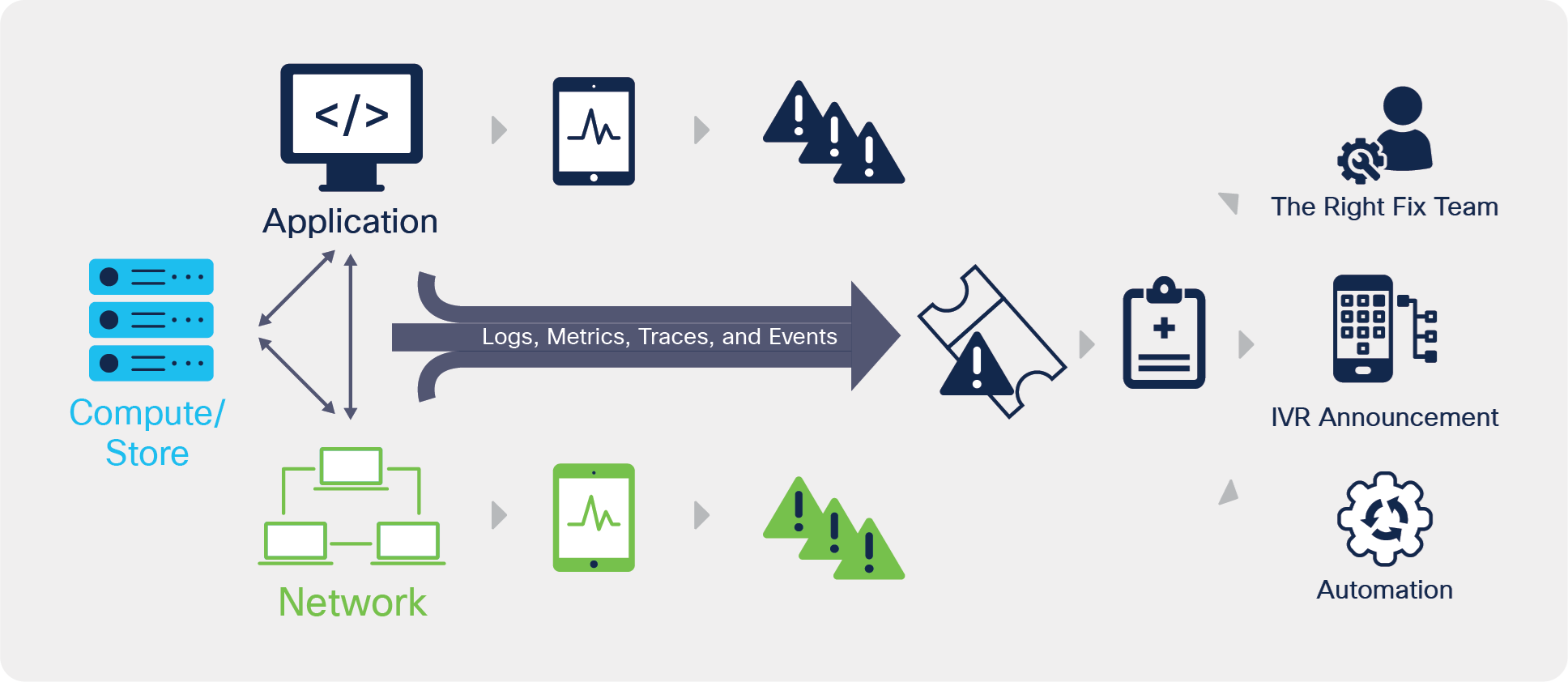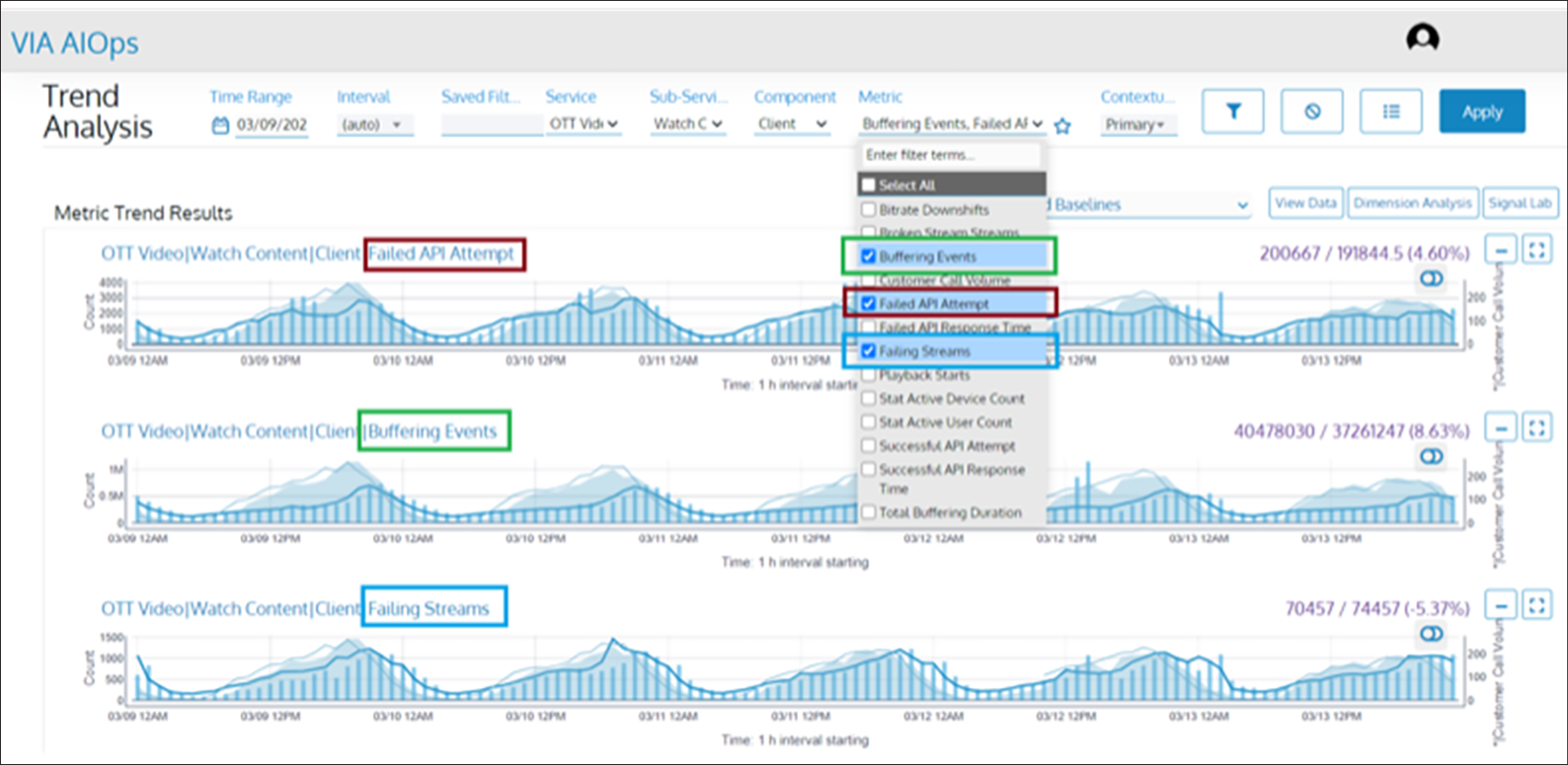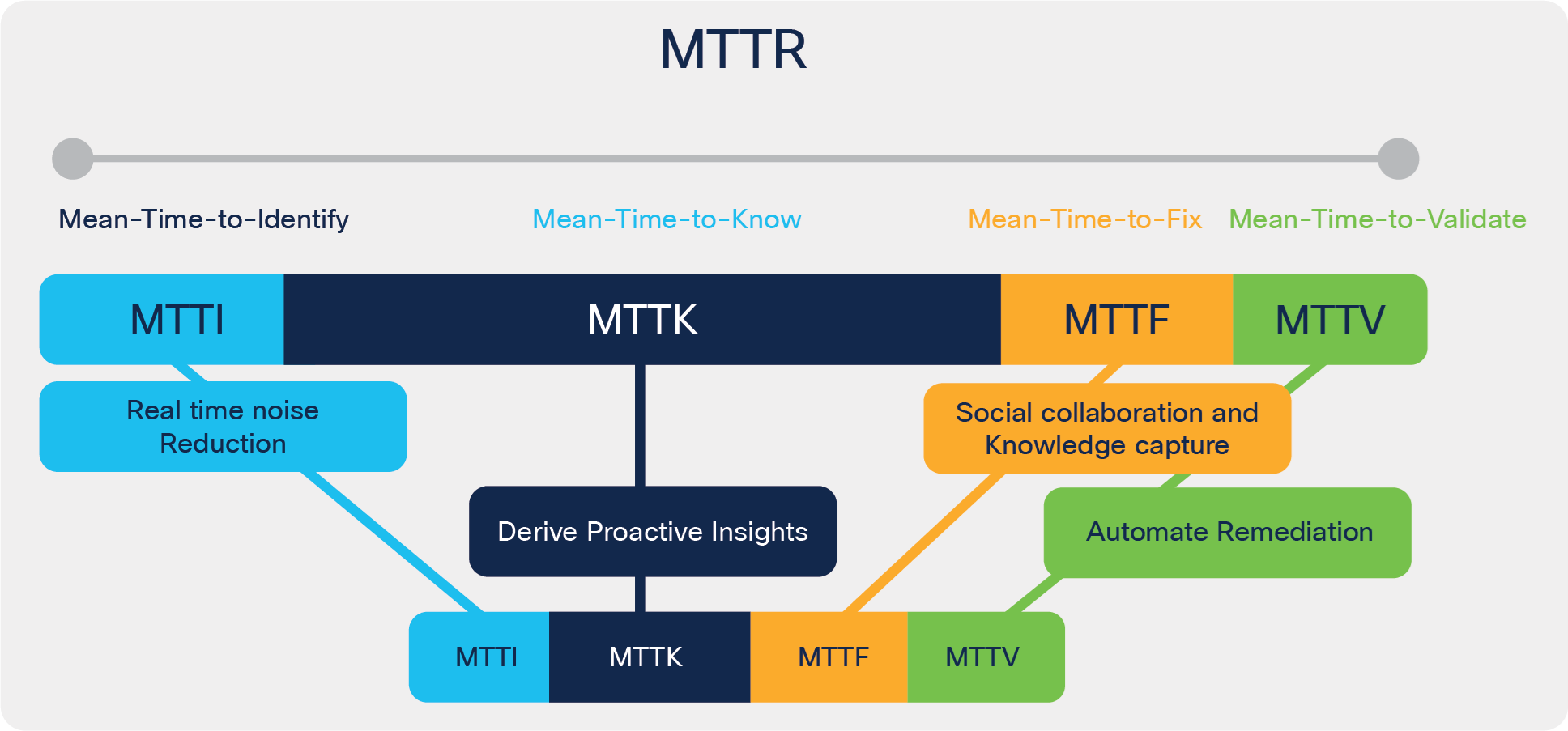Vitria VIA AIOps for Cisco Network Automation Solution Overview
Available Languages
Bias-Free Language
The documentation set for this product strives to use bias-free language. For the purposes of this documentation set, bias-free is defined as language that does not imply discrimination based on age, disability, gender, racial identity, ethnic identity, sexual orientation, socioeconomic status, and intersectionality. Exceptions may be present in the documentation due to language that is hardcoded in the user interfaces of the product software, language used based on RFP documentation, or language that is used by a referenced third-party product. Learn more about how Cisco is using Inclusive Language.
Slow, labor-intensive visual identification and correlation of root cause is required to resolve cross-domain service impacts. That’s why operations teams miss opportunities to quickly detect and resolve service-impacting incidents despite an abundance of monitoring tools. From applications to the underlying network, compute, and storage, each domain is monitored separately as illustrated in Figure 2. Fault and performance management are often managed independently. Change management and customer support are usually not fully integrated within the process.

Vitria VIA AIOps for Cisco® Network Automation delivers automated analysis that enables rapid remediation of service-impacting events across all technology and application layers.

VIA AIOps operates through the entire event pipeline from observation to analysis and action to reduce the time to diagnose and resolve issues faster through automation
Interdependent systems and applications often make it difficult to discover and then fix the true cause with legacy fault management systems.

Legacy fault management systems with siloed monitoring systems
Vitria VIA AIOps for Cisco Network Automation handles fault, performance, and change management across service domains as depicted in Figure 3. Automated intelligent workflows enable rapid resolution of performance and customer-impacting events to deliver measurable service assurance improvement. The result is a reduction in the overall cost of addressing performance issues and improving the customer experience by accelerating the time to not only detect issues, but also resolve them.
To find the cause quickly, you need to see and react to the interplay across the service elements to distinguish between the cause and the symptoms and then fix it fast.

Fault and performance management with Vitoria VIA AIOps for Cisco Network Automation
● Scales to billions of analyzed data points with an open core foundation
● Gain visibility and discover dependencies within and between systems and across service layers to support fault, performance, and change management
● Uncover the how and why of system behavior to enable active response
● Detect issues and service anomalies fast before they impact service performance and result in unnecessary operational cost through advanced anomaly detection
● Determine the probable root cause through ontology, topology systems discovery and correlation analysis
● Support cloud-native environments and simplify operations with unified data collection that accepts metric, log, event, and trace data
Increasing infrastructure complexity and scale
Digitization demands that service delivery infrastructure be scalable and extensible to support growing numbers of applications, services, and subscribers. From an operational perspective, the systems need to effectively deal with technology layers, domains, a large number and variety of devices, data volumes, and disparate data formats while delivering a simplified experience to improve operational efficiency. Virtualization adds complexity by decoupling the software from the underlying hardware and dynamic workload-based scaling. Microservices adds additional complexity by decomposing applications into discrete services. The velocity of application changes and the endless number of potential endpoints exacerbate service assurance challenges.
Traditional fault management systems rely upon siloed monitoring tools. Each monitoring system generates volumes of alarms. Interrelated issues across systems result in multiple tickets being opened and separate teams taking actions that may not be addressing the true root cause, wasting time and resources. While this traditional fault management process plays out, customer frustration climbs.
To reduce the time to detect issues, accelerate resolution, and reduce cost, signals across the operating environment from the IT elements to the network and the application must be ingested, correlated, and analyzed together. Effective fault management requires noise reduction and root cause analysis across service layers through automation.
Vitria VIA AIOps for Cisco Network Automation delivers improvement within the entire service assurance lifecycle, moving from noise reduction and fault detection to performance management and predictive analytics within and across the infrastructure, network, and applications. Designed to run and collect data in cloud-native environments from a wide range of sources, cloud-based application monitoring, dynamic data correlation, and root cause analysis can be implemented across vertical and horizontal application clusters, improving detection and resolution time and enabling operational cost reduction.
Vitria VIA AIOps provides the capabilities to deliver end-to-end service assurance as summarized in Figure 4.

Vitria VIA AIOps for Cisco Network Automation end-to-end service assurance architecture
Full stack observability provides the right information on a timely basis to the right people to improve their efficiency and effectiveness. Persona-based views are delivered through an intuitive and dynamic UI. Views and dashboards are generated based on the data, saving staff development time. Ad hoc forensic analysis provides the flexibility required to meet unique user and environment requirements.
AI, machine learning, and advanced analytics reduce alert volume, detect service-impacting issues earlier, and distinguish symptoms from root cause across the technology stack and operational silos. Vitria VIA AIOps for Cisco Network Automation automatically determines the correct algorithm to use on collected data to generate baselines and detect signals. This enables operations teams to focus their attention only on the anomalies requiring action. False positives and true negatives are filtered out, improving operator effectiveness and reducing operator fatigue from excessive alert volumes. Baselines using intraday seasonality identify performance issues earlier than threshold-based systems, improving both the mean time to detect and mean time to repair. Continuous learning sustains optimal baselines across billions of dimensions and metrics with dynamic baseline changes as new data is collected.
Real-time analytic pipeline collects, enriches, and analyzes streaming data in real time and delivers dynamic analysis and root cause identification across vertical and horizontal applications and workload layers (see Figure 5). Vitria VIA AIOps for Cisco Network Automation makes existing systems and fix agents more efficient with intelligent and timely insights.
Unified data collection enables the Vitria VIA AIOps for Cisco Network Automation application to be implemented to optimize fault, performance, and change management processes and used for both traditional in-house and cloud-based application environments. Never-before-seen data can be directly incorporated into performance and fault management processes in a matter of minutes. MIB data can be more quickly incorporated into service assurance management processes. New traps can be ingested without code changes. Operations become more efficient by eliminating the development of thousands of lines of code to ingest and parse data sets.
● Ingests metrics, logs, events, and trace data via native connectors from applications, network, and infrastructure monitoring tools
● Collects and analyzes data from cloud-native environments from a wide range of sources
● Onboards raw data in standard and nonstandard formats
● Automates the preparation and capture of MIB data
● Data is not required to fit a specific data model or data specifications
Open Core Foundation enables integration with existing service management and monitoring systems. Integration allows Vitria VIA AIOps for Cisco Network Automation to prescribe actions to these systems, including opening, closing, or updating a ticket, engaging the right fix agent, and notifying teams of the symptoms and probable causes of the event. Built on best-of-breed open-source tools and platforms, including HDFS, Kafka, Spark, and Druid, Vitria VIA AIOps for Cisco Network Automation reliably supports mission-critical applications with the ability to scale to billions of analyzed data points.

Vitria VIA AIOps analytic pipeline
Asynchronous and time services events are enriched in real time, deduplicated, and then analyzed to reduce noise, detect incidents rapidly, and identify root cause.
System requirements
The sizing recommendations below are guidelines for small, medium, and large Vitria VIA AIOps for Cisco Network Automation installations.
Fault Management Use Cases
|
|
Small |
Medium |
Large |
| Input data* |
200 hosts |
1600 hosts |
3600 hosts |
| Processor type |
48 cores |
184 cores |
344 cores |
| Memory (RAM) |
192 GB |
592 GB |
1232 GB |
| Network adapter |
1000 |
1000 |
1000 |
| Disk storage |
3 TB |
10 TB |
20.5 TB |
Performance Management Use Cases
|
|
Small |
Medium |
Large |
| Input data |
1 GB/day processed data |
15 GB/day processed data |
35 GB/day processed data |
| Processor type |
48 cores |
184 cores |
344 cores |
| Memory (RAM) |
192 GB |
592 GB |
1232 GB |
| Network adapter |
1000 |
1000 |
1000 |
| Disk storage |
3 TB |
10 TB |
20.5 TB |
| Fault Management |
● Reduce noise and incident detection time through deduplication, analytics, and event correlation
● Only incidents that should be actioned are flagged in the incident inbox (see Figure 6)
● Accelerate time to resolve with incident analysis that delivers probable root cause, symptoms, and populations impacted
|
| Performance Management |
● Analyze time series and KPI data in real time (see Figures 7 and 8)
● Detect service and customer-impacting incidents faster
● Trigger automated action for incident remediation or prevention
● Reduce the number of customer support contacts
● Sustain optimal performance by combining learned and taught behavior
|
| Change Management |
● Monitor for and detect customer experience impact through analysis and correlation of entity attribute changes
● Reduce cost, save time, and improve performance with the artificial intelligence and advanced analytics
|
When incidents are detected, they are automatically flagged in the incident inbox based on severity. Each incident detected can be inspected with details on the service affected, duration, impacted populations, and the related causals of the incident.

Incident inbox summary
VIA AIOps automatically defines the correct algorithm to use on the data. Baselines are developed and continuously fine-tuned as more data is collected. Seasonality baselining can more quickly detect anomalies as compared to simple threshold settings.

Trend analysis
Dependencies within and across the technology stack can be learned or taught. Dimension discovery analysis is key to determining the root cause and the identification of the next best action.

Dimension analysis
Orchestrating AIOps service context with Cisco NSO
Cisco NSO is an industry-leading orchestration platform for hybrid networks. It provides comprehensive lifecycle service automation to enable the design and delivery of high-quality services much faster and more easily, reinforcing the digital transformation. In addition, it simplifies the automation of configuration tasks in a rapidly growing, complex network environment.
Gartner found that Mean Time To Identify (MTTI) and MTTK make up to 80% of the total MTTR. Applying AI and machine learning techniques substantially reduces MTTI and MTTK, as show in Figure 9. Reducing the MTTI and MTTK greatly reduces the overall MTT.

Reducing MTTR (note to reviewer – this figure is from the most recent Cisco whitepaper we updated)
Deploying Vitria VIA AIOps for Cisco Network Automation in conjunction with Cisco NSO helps enrich the service context, delivering the following benefits:
● Bridge the disconnect between service and infrastructure views. Enrich AIOps data with service and device attributes such as service name, service components, and topology to help correlate them across the service and infrastructure layers.
● Keep up with dynamic infrastructure. Subscribe to Cisco NSO for any changes in the service lifecycle status, underlying service components, and topology to help ensure accuracy in the analytics outcomes using machine learning techniques.
● Prioritize based on business and service impact. Enrich AIOps with customer attributes, which, when correlated with the service and infrastructure information, helps to characterize the impact of the issues that require attention from the operator.
● Automate service assurance through a model-driven approach. Cisco NSO enables “orchestrated assurance” to validate service status at the time of service provisioning and monitor service health throughout the service lifecycle. Based on the assurance intent expressed in the YANG model in conjunction with the definition of the service, NSO can configure the device instrumentation, such as Simple Network Management Protocol (SNMP) and model-driven telemetry pertaining to a specific service. It can provision active probes to monitor end-to-end service status. It can also configure the AIOps system to contextualize and analyze streamed data during the entire service lifecycle, immediately after the service is provisioned until it is retired.
● Simplify multivendor device configuration. Cisco NSO offers a single interface to configure all devices as part of closed-loop automation.

Over-the-top video service provider improves their customers’ experience
Challenge: A video service provider was experiencing over 140,000 failed application access attempts per day, causing significant customer satisfaction issues.
Solution: Vitria VIA AIOps for Cisco Network Automation was deployed to correlate application failures to network elements identifying the root cause, triaging automatically, and assigning the service incidents to the correct fix team.
Benefits:
● Improved application access performance
● Reduced call center interactions by over 250,000
● Reduced failure rate by 28%
Regional bank easily enables new services
Challenge: A regional bank decides to integrate neo-banking services to prevent customer erosion. This introduces more advanced technology and will increase the number of digital transactions challenging service operations.
Solution: Vitria VIA AIOps for Cisco Network Automation was deployed to auto-detect controllable infrastructure and network changes directly impacting the integrated services and new products.
Benefits:
● Lowered per account cost structure
● Limited abandoned transactions for transfers, deposits, and lookups
● Saved one million dollars in the first year by replacing manual, reactive tasks with automated, proactive workflows
● 70% reduction in mean time to repair
North American cable operator reduces service dispatch and saves $16 million
Challenge: DevOps, continuous innovation and development, and constant network upgrades were causing unplanned and undetected outages.
Solution: Auto-discovery of dependencies and correlation analysis enabled automatic detection of customer-impacting events through the deployment of Vitria VIA AIOps for Cisco Network Automation.
Benefits:
● Change-related service impact events are now immediately detected, and service technician dispatches are avoided.
● Estimated savings of $16 million due to millions of avoided technician visits.
The Cisco and Vitria SolutionsPlus Partner Advantage
Vitria is proud to announce that it has become an official member of the Cisco DevOps SolutionsPlus Program. This means that CSPs worldwide are able to approach Cisco and approved Cisco partners to purchase Vitria VIA AIOps as a validated solution and addition to Cisco Crosswork™.
The customer service experience is fragile. Service operations management teams need complete awareness of service performance impacts across the application, network, and infrastructure to rapidly detect, triage, and resolve incidents. Despite an abundance of monitoring, it’s not possible to quickly determine the root cause of service-impacting issues. Without all the information across service layers and the right analytic support, high-cost technicians in multiple teams often chase symptoms, wasting valuable time and slowing the resolution process.
Vitria VIA AIOps for Cisco Network Automation leverages artificial intelligence, machine learning, and advanced analytics to identify faults, performance, and customer experience issues faster and determines root cause. Vitria VIA AIOps for Cisco Network Automation also identifies the impacted population for targeted remediation, integrates with existing backend systems, and enables process automation.
Flexible payment solutions to help you achieve your objectives
Cisco Capital makes it easier to get the right technology to achieve your objectives, enable business transformation and help you stay competitive. We can help you reduce the total cost of ownership, conserve capital, and accelerate growth. In more than 100 countries, our flexible payment solutions can help you acquire hardware, software, services and complementary third-party equipment in easy, predictable payments. Learn more.
Start improving your end-to-end service assurance
Are you achieving optimal service performance across your service domains?
Learn how you can lower cost and improve your operational efficiency. For more information on Cisco’s network automation portfolio for service providers, please visit www.cisco.com/go/crosswork. To learn more about Vitria VIA AIOps for Cisco Network Automation or to schedule a demonstration, contact your Cisco sales representative.